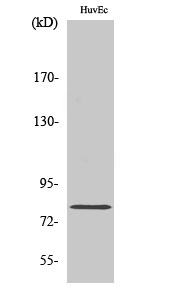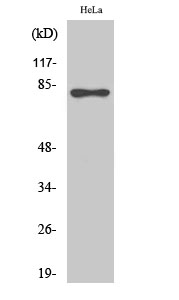Phospho RAD17 (S645) Cell-Based Colorimetric ELISA Kit
- Catalog No.:KA1219C
- Applications:ELISA
- Reactivity:Human;Mouse
- Gene Name:
- RAD17
- Human Gene Id:
- 5884
- Human Swiss Prot No:
- O75943
- Mouse Swiss Prot No:
- Q6NXW6
- Storage Stability:
- 2-8°C/6 months
- Other Name:
- Cell cycle checkpoint protein RAD17 (hRad17) (RF-C/activator 1 homolog)
- Detection Method:
- Colorimetric
- Background:
- function:Essential for sustained cell growth, maintenance of chromosomal stability, and ATR-dependent checkpoint activation upon DNA damage. Has a weak ATPase activity required for binding to chromatin. Participates in the recruitment of the RAD1-RAD9-HUS1 complex onto chromatin, and in CHEK1 activation. May also serve as a sensor of DNA replication progression, and may be involved in homologous recombination.,induction:By X-ray irradiation (isoform 1, isoform 3 and isoform 4).,PTM:Phosphorylated. Phosphorylation on Ser-646 and Ser-656 is cell cycle-regulated, enhanced by genotoxic stress, and required for activation of checkpoint signaling. Phosphorylation is mediated by ATR upon UV or replication arrest, whereas it may be mediated both by ATR and ATM upon ionizing radiation. Phosphorylation on both sites is required for interaction with RAD1 but dispensable for interaction with RFC3 or RFC4.,similarity:Belongs to the rad17/RAD24 family.,subcellular location:Phosphorylated form redistributes to discrete nuclear foci upon DNA damage.,subunit:Part of a DNA-binding complex containing RFC2, RFC3, RFC4 and RFC5. Interacts with RAD1 and RAD9 within the RAD1-RAD9-HUS1 complex. Interacts with RAD9B, POLE, NHP2L1 and MCM7. DNA damage promotes interaction with ATR or ATM and disrupts interaction with the RAD1-RAD9-HUS1 complex.,tissue specificity:Overexpressed in various cancer cell lines and in colon carcinoma (at protein level). Isoform 2 and isoform 3 are the most abundant isoforms in non irradiated cells (at protein level). Ubiquitous at low levels. Highly expressed in testis, where it is expressed within the germinal epithelium of the seminiferous tubuli. Weakly expressed in seminomas (testicular tumors).,
- Function:
- cell cycle checkpoint, DNA replication checkpoint, DNA damage checkpoint, DNA metabolic process, DNA replication,regulation of DNA replication, DNA repair, response to DNA damage stimulus, cell cycle, mitotic cell cycle checkpoint,intracellular signaling cascade, regulation of mitotic cell cycle, negative regulation of DNA replication, negative regulation of biosynthetic process, negative regulation of macromolecule biosynthetic process, negative regulation of macromolecule metabolic process, regulation of phosphate metabolic process, regulation of DNA replication initiation,negative regulation of cellular biosynthetic process, DNA integrity checkpoint, negative regulation of DNA replication initiation, cellular response to stress, regulation of phosphorylation, DNA damage response, signal transduction,negative regulation of nucleobase, nucleoside, nucleotide and nucleic acid metabolic p
- Subcellular Location:
- Nucleus . Phosphorylated form redistributes to discrete nuclear foci upon DNA damage.
- Expression:
- Overexpressed in various cancer cell lines and in colon carcinoma (at protein level). Isoform 2 and isoform 3 are the most abundant isoforms in non irradiated cells (at protein level). Ubiquitous at low levels. Highly expressed in testis, where it is expressed within the germinal epithelium of the seminiferous tubuli. Weakly expressed in seminomas (testicular tumors).
- June 19-2018
- WESTERN IMMUNOBLOTTING PROTOCOL
- June 19-2018
- IMMUNOHISTOCHEMISTRY-PARAFFIN PROTOCOL
- June 19-2018
- IMMUNOFLUORESCENCE PROTOCOL
- September 08-2020
- FLOW-CYTOMEYRT-PROTOCOL
- May 20-2022
- Cell-Based ELISA│解您多样本WB检测之困扰
- July 13-2018
- CELL-BASED-ELISA-PROTOCOL-FOR-ACETYL-PROTEIN
- July 13-2018
- CELL-BASED-ELISA-PROTOCOL-FOR-PHOSPHO-PROTEIN
- July 13-2018
- Antibody-FAQs


